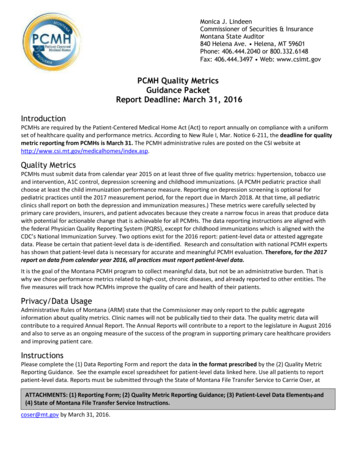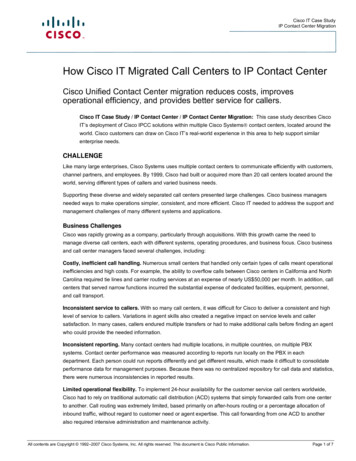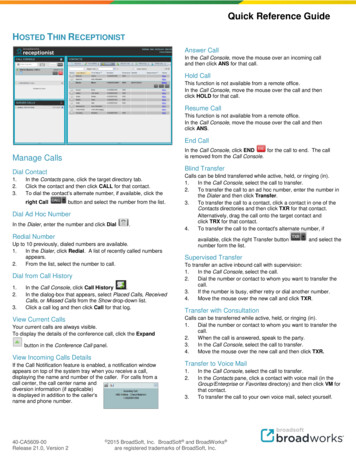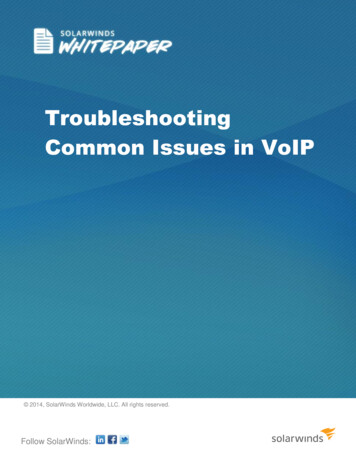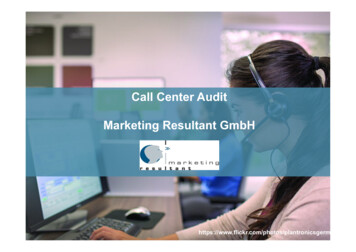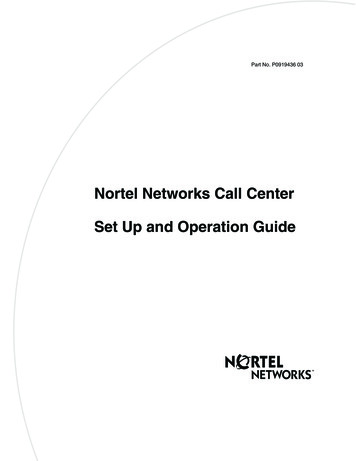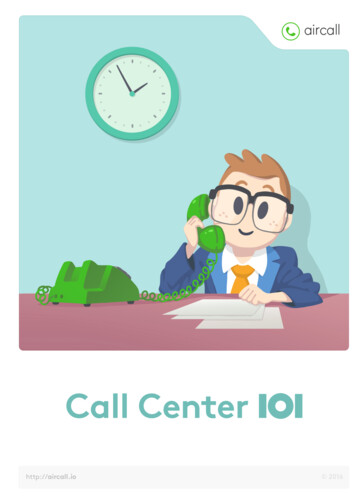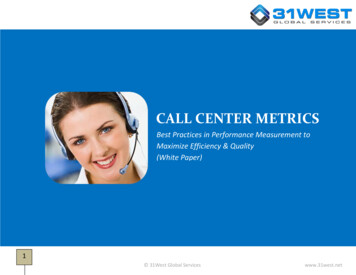
Transcription
CALL CENTER METRICSBest Practices in Performance Measurement toMaximize Efficiency & Quality(White Paper)1 31West Global Serviceswww.31west.net
CONTENTSOverview . 31. Service Level . 42. Agent Schedule Adherence . 63. Active and Waiting Calls . 74. First Call Resolution . . 85. Call Abandonment . 106. Average Handling Time . . 117. Customer Satisfaction . 128. Contact Quality . . 139. Forecast Accuracy . 1410. Net Promoter Score . 1511. Staff Turnover/Retention . . 1612. Blockage . . 1713. Staff Shrinkage . . 1814. Up-Sell/Cross-Sell Rate . 1915. Cost Per Call . 20Conclusion . 212 31West Global Serviceswww.31west.net
OVERVIEWThis paper seeks to help call centers outline their basic needs, such asstreamlining their staffing structure, to overcome forecasting workload.This paper is a primer for standard technology structure of call centersand helps them provide consistent quality to clients and customers.Furthermore, this paper outlines guidelines in performancemeasurement and management to maximize efficiency and quality ofservice for a call center. The practices listed herein form the back boneof any call center. These, among others, are issues that are addressed inthis paper.3 31West Global Serviceswww.31west.net
ISERVICE LEVELa set percentage of calls within a certain number of seconds.For instance, a contract between an Internet Service Provider (ISP) and acustomer shall specify, usually in measurable terms, what services thenetwork service provider will furnish.What is Service Level?A Service Level Agreement (SLA) is a contract or a part of a servicecontract which defines the service. In other words, SLA is an agreementthat defines the terms of service that exist between a service providerand their customer. An SLA is your call center's promise to provide acertain standard of service to your clients and customers and to be morespecific, stipulates that your call center is committed to answering a setpercentage of calls within a certain number of seconds.Types of Service Level AgreementSLA can be used in many areas; there are several types of SLA that maybe used. Some of them are as follows:1. Customer SLA: Where there is an agreement between anindividual customer and a company.2. Service SLA: Service SLA is for every customer making use of theservices being provided by a company, e.g. Response timefor emails.3. Multi-level SLA: It is a combination of levels with the purpose ofaddressing multiple sets of customers.4. Corporate SLA: This includes all Service Level Management (SLM)issues.5. Customer Level SLA: This includes all SLM issues that apply to aparticular group of customers.6. Service Level SLA: This includes all SLM issues that apply tospecific services.If service levels are fluctuating, you need to know about itimmediately in order to solve the problem. Service levels may be4 31West Global Serviceswww.31west.net
ISERVICE LEVELinfluenced by a range of issues, such as unexpectedly high callvolume, unplanned service outages, or high agent absenteeism.Some SLA metrics may be specified as:1. The percentage of the time that services will be available for.2. The total number of users that can be served simultaneously.3. Defined performance benchmarks which help compare actualperformance vs the benchmark periodically.4. Advance notification of changes that may affect users.5. Help desk response time for various classes of problems.6. Dial-in access availability.7. Usage statistics that will be provided.It's important to monitor service levels in real time, as it provides anactive barometer of your call center's current performance.5 31West Global Serviceswww.31west.net
II8.SCHEDULE ADHERENCETips to Ensure Solid Schedule AdherenceWhat is Agent Schedule Adherence?Adherence to schedule is a measurement of how much time during anagent's shift he or she is logged in and handling. It is an overall callcenter measure and is also one of the most telling measures of team andindividual performance.Schedule adherence is an important factor for call center performance;low adherence rates may result in failure to meet SLAs and deliver poorquality of service to customers. There is however a danger of focusingtoo stringently on adherence to schedule since it inevitably results ineliciting cries of micro-management from the agents.Here are a few tricks to ensure solid adherence statistics that agentswon’t find intrusive:1. Train each agent on impact on the queue, and on customeraccessibility and satisfaction.2. Establish concrete service level and response time objectivesknown to everyone.3. Educate agents on the essential steps involved in resourceplanning to ensure that they understand how schedules areprepared.4. Develop appropriate priorities for the tasks your agents performon the job.5. Provide real-time information to agents and back it up with data.6. Track and manage Schedule Adherence at the supervisory level.7. Track Schedule Adherence for the entire group for planningpurposes. This, in turn, will help assess how well effective theprocess that enables Schedule Adherence is.A call center needs to have an idea about how many calls theaverage agent is handling and how long those calls last so as tohelp pinpoint any scheduling adjustments that may have to bemade.6 31West Global Serviceswww.31west.net
IIIACTIVE & WAITING CALLSWhat are Active and Waiting Calls?The ‘Active and Waiting Calls’ measures current volume of active callscompared to the number of callers waiting to be patched through to anagent.This is a real-time status metric that should be shared with all the agentsto offer them insight on their performance. Agents should beencouraged to resolve calls on a timely basis in order to get to the nextcaller in queue and not keep the callers on wait.However, this should never come at the expense of delivering qualitycustomer service. Remember, the more the Wait Time the harder thecaller becomes to handle.7 31West Global Serviceswww.31west.net
IVFIRST CALL RESOLUTIONWhat is First Call Resolution?Benefits of First Call ResolutionThe percentage of transactions that are completed within a singlequery/contact is called the first call resolution (FCR) rate and is a crucialmeasure of quality.The objective of any service center is to quickly resolve calls to meetservice level agreements and deliver a high quality of service. Issues thatare resolved on the first contact display the efficiency of a call centerand attract greater customer satisfaction.There are, no doubt, issues that cannot be resolved without multiplecalls or contacts. For example, a difficult technical issue may involvemultiple contacts with several agents in order to resolve the issue. Theresolution rate will likely be lower in case of emails, since it generallytakes multiple messages between the customer and the agent to resolvean issue.Listed below are a few benefits of FCR:1. Reduces Operating Costs: A low FCR rate results in a highnumber of repeat callers. This escalates the wait time,disconnections and call-backs. Reducing the cost burden ofcallbacks is one of the major benefits of FCR.2. Customer Retention: A high FCR makes a customer feelcomfortable with the support and is a very good way to avoidlosing your customers to competitors.3. Higher Employee Satisfaction: The strain on agents who mustcontend with frequent callbacks from often-frustratedcustomers is significant and invariably leads to low morale, poorcustomer service and high agent turnover.8 31West Global Serviceswww.31west.net
IVFIRST CALL RESOLUTIONRecent studies have shown that the FCR rate has the highest correlationwith customer satisfaction. Nothing impacts customers’ perceptionsabout a company or its support more than simply getting their questionanswered or problem resolved on the first try.The red flag associated with FCR is the number of issues that arecurrently unresolved. Ensure consistent tracking of each contact methodthat your call center uses, as well as how effective each method is.It’s not easy to figure out FCR; it takes some collating of informationfrom your contact management system, but it’s worth the extra effort.Remember, the higher your FCR rate, the happier your customers are!9 31West Global Serviceswww.31west.net
VCALL ABANDONMENTWhat is Call Abandonment?Call Abandonment measures the number of calls that are disconnectedbefore they can be connected to one of your agents. This metric isclosely related to Service Level and Customer Satisfaction. Customersare not expected to be patient. They will hang up and possibly switchtheir brand loyalties.Abandonment rate is not typically a measure associated with emailcommunications, since the email does not abandon the “queue” once ithas been sent, but it does apply to web chat interactions and inboundcalls.Please note, that abandon rate is not entirely under the call center’scontrol. While abandons are affected by the average wait time inqueue (which can be controlled by the call center), there are amultitude of other factors that influence this number, such asindividual caller tolerance, time of day, availability of servicealternatives, and so on.10 31West Global Serviceswww.31west.net
VIAVERAGE HANDLING TIMEWhat is Average Handling Time?Factors that can distort AHTAverage Handling Time (AHT) is a measure for any contact center thattells you how long a new item of work takes to be handled, and not justthe talk time. It can also be defined as a common measure of contacthandling, made up of talk time plus after-call work (ACW).AHT is also a measure that is important in determining the other typesof multichannel contact workload. It is much harder to calculate howlong it takes to handle an email or a Web chat transaction. An email maybe opened and put aside for varying amounts of time beforecompletion. Likewise, a web chat session may appear to take longerthan it actually does. Therefore the simplistic start and end time figuresgive an inflated picture.1. Cutting off callers. If you target agents on their AHT you may findthat they cut off long callers or, if a call looks difficult, theytransfer it to another department.2. Wrap-up time should only be used for time related to theparticular call. However, there is scope for misuse since someagents may use this to stop taking the next call.3. You need to include Hold Time in the calculation, as not doing socan result in agents spending more time unnecessarily on hold inorder to reduce the total AHT.4. Slow Computers (a rather ubiquitous problem)5. Spending time with a caller to resolve a problem.6. Poor training programs.7. Long periods of hold time.Average Handling Time Formula11 31West Global Serviceswww.31west.net
VIICUSTOMER SATISFACTIONWhat is Customer Satisfaction?Customer satisfaction is one of the most critical metrics for any contactcenter. It provides an assessment of your call center's performance fromyour customer's perspective.While there is no standard method for calculating customer satisfaction,there are certain common practices and processes that enable leadingcenters to not only effectively and efficiently keep tabs on just howmuch customers dislike them, but also to make key improvementsbefore customers take their business elsewhere. This data is usuallycollected through customer surveys that ask general questions, relatingto call quality, call resolution, and how satisfied the customer was withthe service received (regardless of outcome).Today's advanced IVR survey apps can be programmed to recognizewhen a customer gives an abnormally low overall rating and to sendan alert to the center manager or quality assurance team.12 31West Global Serviceswww.31west.net
VIIICONTACT QUALITYWhat is Contact Quality?Contact Quality is a very common and critical customer-centricperformance metric in all contact centers, regardless of industry,function and size. Contact quality is typically assessed by first monitoringand recording of agent interactions with customers. These interactionsare rated by quality assurance specialists using a comprehensiveevaluation form that features key criteria that contributes to a qualityinteraction from the customer's perspective.While monitoring and recording is by far the mostcommon method used for assessing contact quality, somequality measurements may be generated from reportsgenerated by customer information systems.Common quality criteria:1.2.3.4.5.6.7.Use of appropriate greetings and other call scriptsCourtesy and professionalismCapturing key customer dataProviding customers with correct and relevant informationFirst-contact resolutionAccuracy in data entry and call codingGrammar and spelling in text communication (email and chat)13 31West Global Serviceswww.31west.net
IXFORECAST ACCURACYWhat is Forecast Accuracy?Forecasting accuracy is better described as forecasted contact load vs.actual contact load. It is a performance metric that reflects the percentvariance between the number of inbound customer contacts forecastedfor a particular time period and the number of said contacts actuallyreceived by the center during that time period.Underestimating the forecast leads to understaffing, in turn, leading tolong wait times in queues, frustrated customers, burned-out agents andhigh toll-free costs. However, overestimating the forecast results inwaste of resources, overstaffing and increased idle time.Forecasting accuracy should not be reported as a summary offorecasted versus actual contacts across a day, week or month.Rather it should be viewed an illustration of accuracy for eachreporting interval, typically half-hours.Forecasted call load is available from the center's workforcemanagement system; actual call load is tracked by the workforcemanagement system, email response management system and Webservers where data is available.14 31West Global Serviceswww.31west.net
XNET PROMOTER SCOREWhat is Net Promoter Score?The Net Promoter Score is based on the premise that every company’scustomers can be divided into three categories: Promoters, Passives,and Detractors.By asking a simple question like "How likely is it that you wouldrecommend [your company] to a friend or colleague?", one can trackthese groups and get a clear measure of your company’s performancefor a customer’s standpoint. Customers respond on a 0-to-10 ratingscale.To calculate your company’s NPS, Subtract the percentage ofcustomers who are Detractors from the percentage ofcustomers who are Promoters.They are categorized as follows:1. Promoters (score 9-10) are loyal enthusiasts who will continuebuying and refer others.2. Passives (score 7-8) are satisfied but unenthusiastic customerswho are vulnerable to competitive offerings.3. Detractors (score 0-6) are unhappy customers who may damageyour brand through negative word-of-mouth.15 31West Global Serviceswww.31west.net
XISTAFF TURNOVER / RETENTIONWhat is Staff Turnover/Retention?The best way to measure the satisfaction of your workforce is to look atthe percentage of staff that leaves. There can be some tellinginformation in these numbers and it is crucial to track and analyze theturnover rates in many ways.One should look at the rate associated with different call types, as it maybe more stressful or less satisfying to handle certain types of calls. Youshould also look at turnover by team to see if there are any supervisoryinfluences in keeping people or driving them away.And you’ll definitely want to look at the level of performance of thepeople leaving. If it’s primarily the worst performers leaving, turnover isnot such a bad thing, but if it’s your better performers leaving thecenter, it may be time to re-examine your compensation, recognitionprograms, and career path opportunities to see what it is that’spreventing the retention of these staff.Remember, Employee Satisfaction is paramount in retaining staff, asis showing opportunities for growth.16 31West Global Serviceswww.31west.net
XIIBLOCKAGEWhat is Blockage?Blockage is a measure of accessibility that indicates what percentage ofcustomers will not be able to get in touch with the contact center at agiven time due to insufficient network facilities.Failure to include a ‘blockage goal’ may allow a contact center to meetits ‘speed of answer’ goal by simply blocking the excess calls; but this is amyopic view of the result. While you might feel that it looks like that thecontact center is doing a great job in terms of managing the queue,blockage can have a negative effect on customer accessibility andsatisfaction.Though this is typically monitored by the IT or telecom departmentand not by the contact center, it should still be a measure that isreviewed regularly to make sure callers are not being turned away atthe front door.17 31West Global Serviceswww.31west.net
XIIISTAFF SHRINKAGEWhat is Staff Shrinkage?Staff shrinkage is the percentage of time that employees are notavailable to handle calls. It is classified as non-productive time, and ismade up of meeting and training time, breaks, paid time off, off-phonework, and general unexplained time where agents are not available tohandle customer interactions.Staff shrinkage is an important number to track, since it plays animportant role in how many people will need to be scheduled for eachhalf-hour slot.It is important to track shrinkage by individual criteria. While someshrinkages are unavoidable, such as paid time off and training time,other criteria of non-productive time should be tracked with theobjective of limiting the loss of available hours over time.The best way to avoid Shrinkage is proper staffing. Usually theworkforce management team checks for the forecast and assigns thestaffing.18 31West Global Serviceswww.31west.net
XIVUP-SELL / CROSS-SELL RATEWhat is Up-Sell/ Cross-Sell Rate?The up-sell rate or cross-sell rate is simply the success rate of generatingrevenue above the original intention of the call. It is becoming anincreasingly common practice, not just for pure revenue-generating callcenters but for customer service centers as well.Also called Revenue per Call (RPC) by some contact centers, Up-Sell orCross-Sell refers to a contact center such as technical support which inorder to boost the company’s (or client’s) revenue, offers the customersother products and features once the call is done.Remember, Up-Selling or Cross-Selling sometimes may also make acustomer angry. Agents need to make sure that they only pitch oncethe issue is resolved up to the customer’s satisfaction.19 31West Global Serviceswww.31west.net
XVCOST PER CALLWhat is Cost Per Call?A major factor determining profits is the cost of running theorganization. A common measure of operational efficiency is costincurred for each minute of handling the call workload, commonlyreferred to as Cost per Call. This cost per call can be simply a labor costper call, or it can be a fully loaded rate that includes payroll in additionto telecommunications, facilities, and other services costs.In setting cost per call, it is critical to define the components beingused, and to use them consistently in evaluating how well the center ismaking use of financial resources over time.20 31West Global Serviceswww.31west.net
CONCLUSIONThe metrics that any call center embraces have an undeniablymomentous impact on the customer experience. Of course, not everymetric can be completely customer-centric as there are operations costsand business needs that must be factored in as well. Focusing strictly onstraight productivity metrics and managing a contact center primarily asa cost center simply not a feasible approach anymore.Emphasizing on these metrics will ensure that your company maintains ahigh standard of customer satisfaction and loyalty, and thus enable yourcenter to be an efficient, high-performing, critical business entity.2443, Fillmore St. #380-4946San Francisco, CA 94115Web: www.31west.netTollFree: (877) 262-5030Email: sales@31west.netLinkedIn Google Twitter Facebook21 31West Global Serviceswww.31west.net
CALL CENTER METRICS Best Practices in Performance Measurement to Maximize Efficiency & Quality (White Paper) 2 . service for a call center. The practices listed herein form the back bone of any call center.These, a


